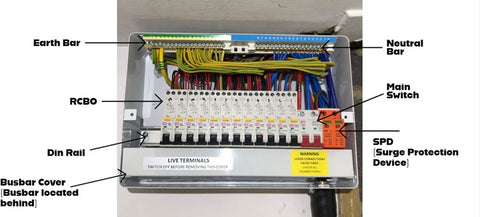The Function of Customer Systems in Effective Power Monitoring Solution
Customer devices are indispensable to reliable energy management systems, serving as the primary circulation factors for electrical power within structures. The introduction of clever technologies has actually better boosted their functionality, allowing for real-time data monitoring and nuanced power consumption analysis.
Understanding Customer Devices

Understanding the duty of customer devices begins with identifying their necessary function in protecting electrical systems. By separating mistakes within certain circuits, consumer devices stop extensive failures and potential fire threats. This seclusion is accomplished through the usage of breaker that trip or fuses that impact when a fault is detected, thereby removing the electric circulation to the impacted circuit.
In addition, consumer systems assist in the orderly distribution of power, improving the effectiveness of energy use. They enable for the methodical monitoring of electric lots, which can be especially essential in industrial and industrial settings where demand can fluctuate considerably. Properly maintained consumer units add to the durability of electric systems and aid in lessening downtime caused by electrical failings, ultimately sustaining the smooth operation of energy-dependent facilities.
Smart Technologies Assimilation

A vital benefit of smart customer devices is their capability to utilize advanced formulas and artificial intelligence for anticipating analytics. This permits preemptive changes based on usage patterns, weather condition forecasts, and other variables, significantly increasing general efficiency. Clever consumer systems promote need reaction programs, where power usage can be dynamically adjusted during height periods to stabilize the grid and minimize expenses.
The assimilation of sustainable power resources, such as solar and wind, is additionally streamlined with wise customer systems. By wisely taking care of the intermittency of these sources, these systems make certain a balanced and trustworthy energy supply. Furthermore, wise consumer systems boost customer interaction by providing comprehensive insights and push-button control capabilities through mobile applications, fostering a more aggressive technique to power conservation and sustainability.
Monitoring Power Consumption
Structure on the capabilities of clever technologies assimilation, checking energy consumption comes to be an essential focus within power monitoring systems. By leveraging advanced metering framework (AMI), real-time data on energy use can be collected at granular degrees, providing valuable understandings into usage patterns and peak need durations.
Smart meters and Web of Points (IoT) tools play a critical function in this surveillance process. These tools can track energy usage in real-time, transmitting data to central systems for evaluation.
The integration of these innovations not just equips consumers with thorough details regarding their power use however likewise sustains energy suppliers in taking care of load circulation better. Ultimately, continuous and accurate tracking is crucial for accomplishing energy performance, cost savings, and sustainability objectives within power monitoring visit site systems.
Optimizing Device Use

One reliable technique entails identifying peak and off-peak hours to move energy-intensive tasks, such as laundry or dishwashing, to times when energy demand is reduced. This not just minimizes strain on the grid yet additionally profits from reduced energy tariffs. Furthermore, integrating maker understanding algorithms enables predictive upkeep, making investigate this site certain home appliances run at optimum effectiveness and lengthening their lifespan.
Energy monitoring systems can likewise integrate user-specific preferences and actions to customize device usage timetables. Smart lights systems can readjust illumination based on occupancy and natural light schedule, while Heating and cooling systems can keep comfort degrees without extreme power use.
Supporting Sustainability
Promoting sustainability within power monitoring systems involves not just enhancing performance yet additionally promoting environmentally liable methods. Customer units are integral to this process, as they supply real-time data and control mechanisms that visit this site right here make it possible for users to keep track of and lower their power usage. By leveraging advanced modern technologies, consumer systems can identify energy-saving chances and promote the combination of sustainable energy resources like solar and wind power.
One important aspect of advertising sustainability is educating customers on the advantages of responsible energy usage. Via thorough understandings offered by customer systems, customers can make enlightened choices that decrease their carbon footprint. As an example, these devices can advise ideal times for running high-energy devices based on grid demand and eco-friendly power schedule, therefore lowering reliance on fossil gas.
Additionally, customer devices sustain the fostering of clever grid innovations, which improve the general performance and dependability of energy distribution. By enabling two-way communication in between consumers and energy suppliers, these systems can dynamically get used to energy demands, reducing waste and promoting using lasting energy practices.
Conclusion
Consumer devices, as important elements of power monitoring systems, dramatically boost electrical safety and performance within structures through circuit protection and clever innovation combination. Real-time data monitoring and evaluation assisted in by these systems optimize power usage and device usage. Additionally, the incorporation of eco-friendly energy resources advertises sustainable methods, adding to decreased overall power consumption and reduced carbon footprints. Subsequently, consumer devices play an important duty in progressing both energy performance and ecological sustainability.
Developments in clever technologies have revolutionized the capacities of energy management systems, especially with the combination of clever customer devices.Building on the capabilities of smart innovations combination, monitoring energy intake comes to be a crucial focus within energy management systems.Efficient home appliance usage optimization is an essential part of power monitoring systems, intending to boost performance and minimize unneeded power usage.Consumer systems, as integral components of power monitoring systems, significantly improve electric security and effectiveness within structures via circuit defense and clever modern technology assimilation. Furthermore, the unification of sustainable energy sources advertises lasting techniques, contributing to decreased overall power intake and reduced carbon footprints.